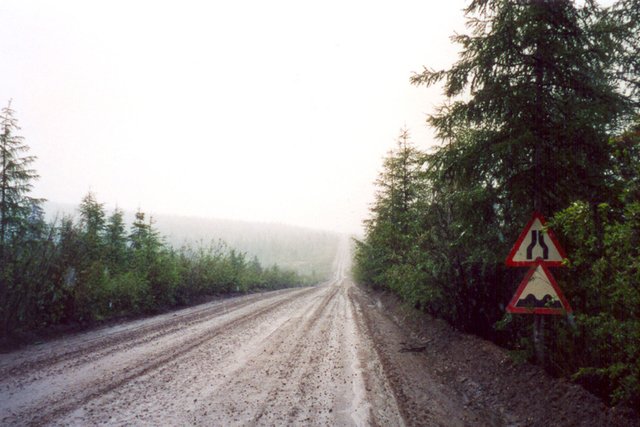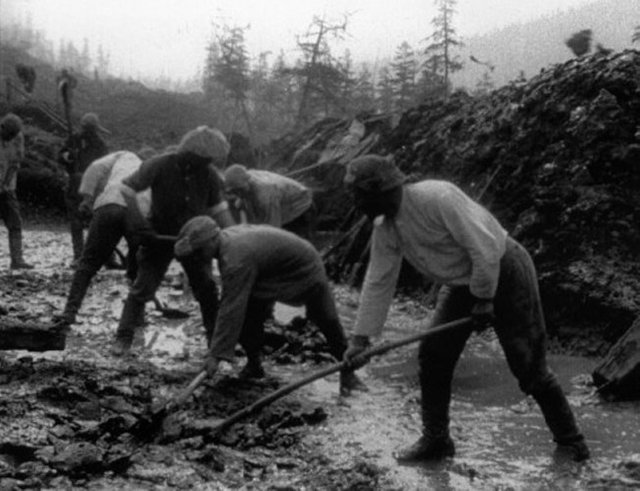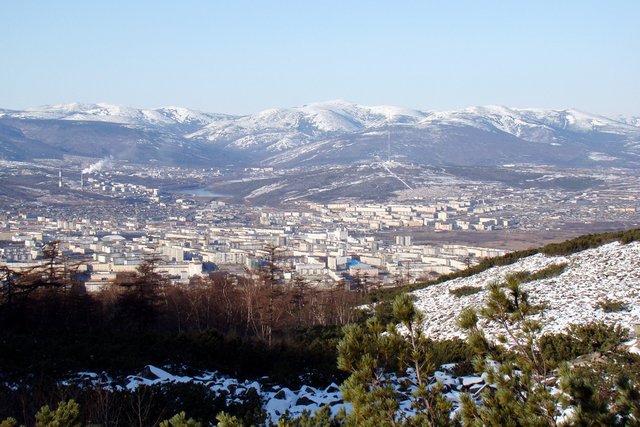The Siberian Bone Road, the still visible footprint of the Soviet Gulag

When Jules Verne wrote Michael Strogoff in the mid-nineteenth century he was taken in by the fantastic stories coming out of Siberia. At that time there were few western travelers who had ventured into the infinite territories beyond the Urals, due to precarious infrastructures and very long traveling times. Without railways crossing such vast plains, the only way to get across Omsk or Irkutsk was by horse-drawn carriage or foot. It was a wild territory that fired the public's imagination.
No wonder the novel captivated so many readers, given the mythological halo that surrounded the Russian Empire's three-century conquest of the East. At that time, Siberia was a territory in full political possession of the tsars, but still wild and untamed. During the following decade's infrastructure, cities, mining, and hydroelectric power stations were developed. But the mental frontier would still reside at the same point where Verne identified it: Irkutsk.
What would be beyond? The construction of the Trans-Siberian Railway made it possible to connect Vladivostok, on the fringes of the Far East, to Moscow. This railway line crossed the most benign latitudes of Siberia, those which were less harsh in winter and which were completely swamped with mosquitoes during the harsh summer months. Above, nothingness. Or rather, the mystery. Huge plots of land that were practically uninhabited and that the machinery of the Empire assumed as its own, despite belonging to nobody.
The omnipotence of the Soviet Union under Iósef Stalin would change the framework of what was possible. During the 1930s, the communist rulers would be interested in the infinite material resources buried in the remote regions of Sakha, Khabarovsk, Chukotka and Kamchatka, those gathered in the Far East of Siberia, perhaps the most remote and distant conjunction of words that any human language can evoke. Russia then began the conquest of that which resided beyond the end of the world. And for that, she needed roads.
# Prisoners building highways #

How to build them? Those regions, so huge, were not easy to tame. Some of the most rugged mountain ranges in Asia are hidden within their boundaries; some of the longest and most brutal rivers on the planet are born and die there. The USSR had a brutal need and very few resources at its disposal to satisfy it. So it resorted to the joker that the Tsars had been using since they pacified Siberia and brought it under their control: the prey population.
By the mid-1930s, the Gulag, the system of concentration and forced labor camps designed by the NKVD, the secret service, was at its peak. The Soviet Union designed a dense network of detention centers where several million prisoners spent their days (and their lives). There was everything, continuing the imperial tradition. From common prisoners accused of robbing or murdering their neighbors to political dissidents, the most famous of whom was more useful in digging trenches in the Krai of Krasnoyarsk than dead.
At its peak, it is estimated that more than 1.5 million people inhabited the cells of the Gulag. But the needs in the Far East of Siberia were very different. There the deposits of gold and uranium were more vast, farther away, and required greater effort. Aware of this, the Soviet authorities created a special region within the system of prison camps called Dalsroy and destined to civilize and develop, by means of the exploitation of natural resources, that lost corner of the world.
The Dalsroy would become one of the most brutal and massive institutions of the Gulag and would obtain total power over all matters relating to those territories. From administrative to legal management, including economic and developmental issues. Its center of operations would be in Magadan, a former fishing village located in front of the Kamchatka peninsula that in a few years would become the main city of the region. Prisoners would arrive there, embarked from points as far away as Vladivostok, to set up mines and lay down roads.
The most famous of them all and the only one worthy of the name at present started precisely from Magadan, and crossed the most frozen territories of the planet, with frequent temperatures below -50 ºC, to reach Yakutsk, the historical capital of the Republic of Sakha and one of the most important urban centers in Siberia. For more than twenty years, thousands of workers would leave their hands and lives building that highway, today officially known as Kolyma Route 504 and popularly known as "The Bone Road".
It is a road of more than 2,000 kilometers that goes into the interior of the Oblast of Magadan following the side of the Kolyma, and that originally served the numerous exploitations of gold, copper, and other minerals that the USSR found upon its arrival. Paved only for the first few kilometers on the outskirts of Magadan, the Bone Road is nothing more than a gravel infrastructure in whose path a handful of localities now in irreparable decline are abandoned.
Its name, as you can guess, comes from the thousands of prisoners who perished during its construction. There are no official and verified figures on the number of deaths under the authority of the Dalsroy. It is known that at its peak, in 1952, around 200,000 prisoners were under its control. By then the road was already well advanced. Stalin's death a year later would definitively close the Gulag, and the subsequent Siberian constructions would be carried out with paid labor.
Despite this, it is easy to imagine how thousands of people could have died building the infrastructure. It is known that the working conditions imposed by the Gulag were extremely harmful. Added to the terrible climatic conditions of the area, the result could only be a bloodletting of the dead. Very close to the road, about a hundred kilometers to the north is the village of Oymyakon, the coldest inhabited point on the planet. Today it still holds the minimum record of humanity: -62 ºC. An extreme, but a significant one.
Driving on a road of bones
The cold, the lack of comfort, the remoteness and abruptness of the place, and the conditions of the time, added to the repressive brutality of the Dalsroy, made death a common element in the construction of the road. Even today the traces of the Gulag are visible wherever you look. When a French photojournalist traveled the route during the winter months she discovered that death permeated everything. Many of the prisoners' grandchildren still live there; monuments to their memory are frequent, and crosses on both sides of the road are very common.
His journey along the Bone Highway also illustrates the decadent state of the region. Magadan, for example, reached half a million inhabitants during the most prosperous years of the Soviet Union, but today, without abundant farms to support the population, it is home to no more than 90,000 people. Worse luck is had by the villages that sprang up around the road. Places like Spornaya or Kadykchan, home to thousands of people once, today completely abandoned.
Those who still live there do so in isolation for much of the year, and connected to the world only by the road. They depend on less profitable activities, such as hunting or reindeer herding, once many mines were closed down. The fall of the USSR and the subsequent economic crisis caused many poorly maintained and unprofitable mines to collapse. And also that some branches of the motorway, once supported by the Soviet administration, fell into disuse.

This is the case of the Old Summer Route, a road that links Kadykchan and Kuybeme in a straight line, crossing small towns like Tomtor and avoiding the long bypass to the north that draws the main road. This route of barely 200 kilometers, more direct than the official one, used to serve several mines. Its definitive abandonment caused the Russian government to desist from maintaining it. Little by little, the road was taken over by nature, by vegetation and by rivers and streams that make it impracticable today.
The road is only operational in winter when the water freezes and cars and trucks can drive on it, and it has become a particular fetish for motorcycle adventurers. It is common for avid explorers to set out on this route, wading through all sorts of waterways, and visiting the small towns that slowly die on their way. If Russia suffers an absolute demographic crisis, its consequences are much more serious in this part of Siberia.
The amazing and wild nature of the motorway has made it the repository of all sorts of myths. A legend of dubious veracity circulates about its own name. Built on a hard layer of permafrost, it would have been easier to raise a passable platform than to dig up the earth, and to prop it up the authorities would have used the bodies of the workers who gradually died on its construction. The Bone Highway would literally be like that.
There have also been sightings of ghostly figures, of an unrealistic nature. Last year an English-language newspaper on Siberian affairs, The Siberian Times, picked up the story of a woman walking along the highway. No luggage, no interest in being assisted by other vehicles, no explanation for her company. Infinite rumors were distributed about her phantasmagorical nature, only plausible in a region of the world where the supernatural continues to exceed the earthly.
The Bone Highway, however, is real, and it is still possible to travel it from one end to the other by motorcycle, car or truck. According to the photos that populate the network, it is a fascinating and probably unique experience. Few land routes connect places as far away from all humanity like this one. Few places on the planet can be explored with a conventional vehicle where nature is still so unknown, so frightening. And very few still carry such a gruesome, black story behind them.